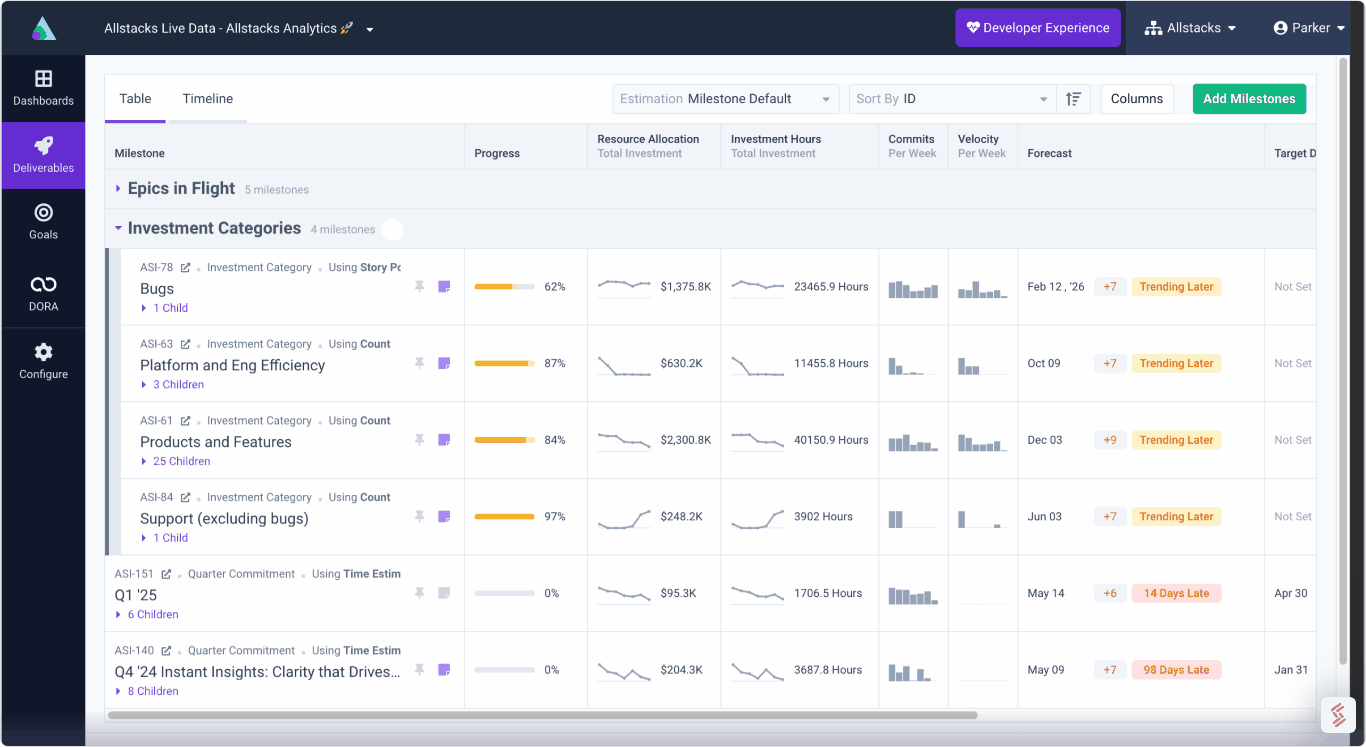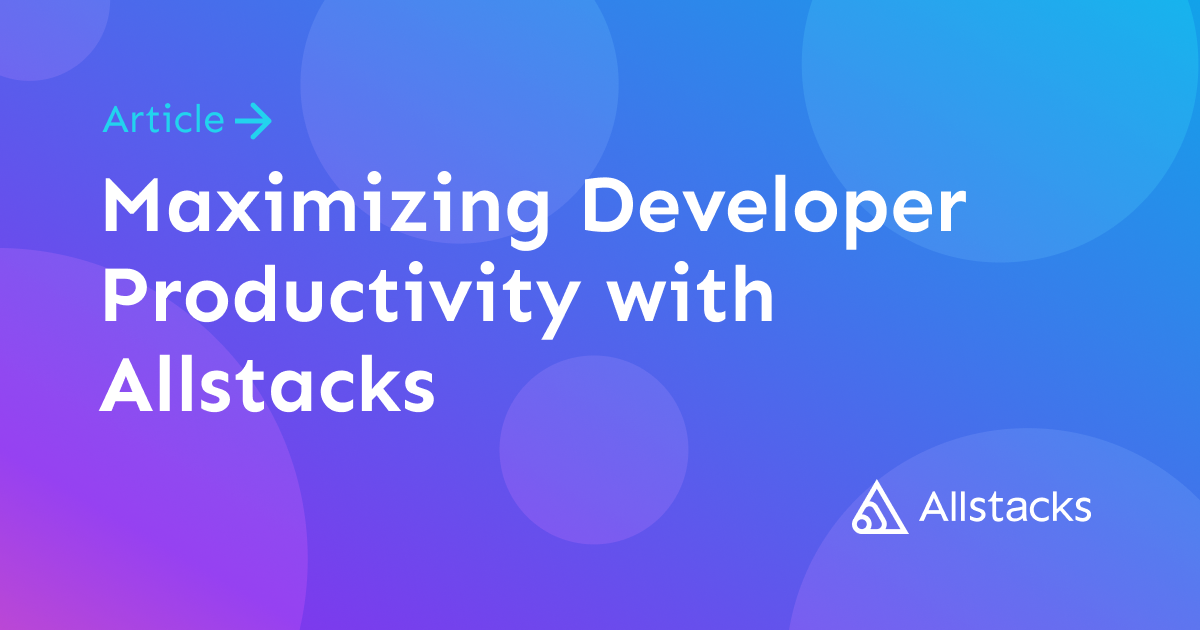.png)
Software Engineering Intelligence
-
Intelligence Engine
On-demand exhaustive AI-analysis
-
Engineering Investment
Complete visibility into time & dollars spent
-
360º Insights
Create meaningful reports and dashboards
-
Project Forecasting
Track and forecast all deliverables
DevEx
-
Developer Surveys
Create and share developer surveys
Software Capitalization
-
R&D Capitalization Reporting
Align and track development costs
Investment to Impact: Connecting Developer Productivity to Business Value
Learn why the path from investment to impact in software development requires clarity, rather than guesswork.
I was having coffee with Jack, a VP of Engineering at a mid-sized SaaS company, when he shared a common frustration. His leadership team kept asking about velocity and DORA metrics, then staring blankly when he explained them. No matter how carefully he broke down delivery frequency or mean time to recovery, they couldn't connect these technical metrics to business outcomes.
This reminded me of an experience at a Mexican restaurant. The waiter, clearly fluent in Spanish, struggled through our conversation in broken English. I speak decent Spanish, at least regarding food, but never switched languages because I started in English. So we struggled unnecessarily because neither of us recognized that we could switch.
"Jack," I asked, "have you ever tried connecting with your CEO in the language of business rather than expecting them to become fluent in engineering terminology? Or do you only communicate in terms of sprints, story points, and deployment frequencies?"
After thinking for a moment, Jack admitted he hadn't. "I always assumed they should learn our metrics since they hired us to build software. But I'm not actually sure how to translate what we do into business terms they'd understand."
This exchange highlights one of the most persistent challenges in technology organizations: communicating the business value of software development investments in language that resonates with business leaders.
The Visibility Gap
For CTOs and technology executives like Jack, there's a fundamental disconnect between funded software initiatives and actual delivered outcomes. Developer teams track their work in tools like Jira and GitHub and report various Agile and DORA metrics, but these metrics rarely provide insight that business leaders can use to evaluate their investment.
In practice, the best-laid plans go awry, urgent issues, maintenance work, technical debt, and process inefficiencies consistently create friction, diverting time from business priorities that would drive the desired outcomes. Technology leaders recognize this risk and implement various processes to help. Still, they're typically working with approximations and proxies for capacity rather than actual data about where time is being spent. They struggle to connect these outcomes to the overall business goals.
Understanding Business ROI in Software Development
When business leaders evaluate investments, they use straightforward ROI concepts: what are we spending vs. what will we make? However, both sides of this equation often remain unclear in software development.
The investment side includes:
- Money: Direct costs of development teams and infrastructure
- Talent: The knowledge and capabilities of engineering teams
- Time: The most critical and finite resource
Business leaders expect these investments to generate returns aligned with strategic objectives. Without visibility into how developer time is actually allocated, the investment remains obscured, and when interruptions challenge results, ROI calculations become impossible.
What most leadership teams see about their technology investments
Most organizations connect investments to outcomes based more on hope than data. They can see high-level goals and expenditures, but it is opaque whether teams are investing commensurate with the business's goals.
Every enterprise CIO I speak to just wants to communicate that they are investing in key priorities and the cost of delivering a feature.
The Hierarchy of Software Development Needs
Organizations often prioritize their engineering efforts in the wrong order. Consider this hierarchy of fundamental questions that should guide technology investments:
- Where are we spending time?
- Is our process effective?
- Are our teams contributing?
[Sidebar: #3 is what’s called a floor metric. In other words, if no one contributes, the other two don’t matter; nothing will get done. But team contributions are no guarantee of success; you need direction and priority in an efficient system to be at your best.]
Expanding from hope: Examine if investments are aligned with key business priorities
Too many organizations over-rotate on building efficient SDLC processes to help developers be more "productive" without first understanding what those processes are pointed toward.
If you’re in Raleigh, NC, trying to drive to California as quickly as possible, maybe you choose a Ferrari because it’s the fastest car you can access. But if you start driving up I-95 heading to New York instead of Highway 40 toward California, you’ll have trouble. It doesn't matter how fast the car moves—it's on the wrong road entirely. You can go as fast as you can imagine, but every mile traveled takes you further from your intended destination.
This analogy applies directly to software development. Orienting work to top business priorities is like getting on the right road. Optimizing development processes is like building a faster car. You're better off driving a slow car on the right road than the quickest car on the wrong one. An efficiently run engineering organization building features that don't address business priorities will simply deliver the wrong outcomes more quickly.
Before investing in process optimization, organizations must be clear on where developer time is being invested and whether those investments align with strategic business objectives.
Aligning Leadership Responsibilities with Investment Intelligence
[Sidebar: Investment Intelligence is a method and concept pioneered by Allstacks that allows an organization to know the true time and money investment that is occurring against key groupings of work. Allstacks leverages the data in your SDLC to identify atomic blocks of time that can be attributed to each of your key initiatives and categories of work to answer questions like: “Will we still be able to generate ROI on this feature?” or “How much are we spending fixing bugs each quarter?”. Investment Intelligence delivers timesheet level time reporting without any manual data collection.]
Organizations that effectively bridge this gap establish clear responsibilities across management levels. Some guidelines we observe in effective technology organizations. Depending on your structure, these responsibilities may shift.
C-Suite and Senior Leadership (e.g., CTOs, VPs)
These leaders must ensure that teams work on initiatives that directly support strategic business objectives. Their primary responsibility is maintaining alignment between development efforts and business priorities.
Key questions they address:
- Are we building the right things?
- Are we focused on our key commitments?
- Can we measure the impact of our technology investments?
Managers of Managers (e.g., Directors, EMs)
Directors focus on creating efficient development processes that remove bottlenecks and enable predictable delivery. Their role often centers on operational excellence—ensuring teams deliver consistently against commitments.
Key questions at this level:
- Is our development process effective?
- Are teams delivering reliably against commitments?
- Are we removing obstacles to productivity?
Direct Managers and Front Line Leaders (e.g., Engineering Managers, Team Leads)
These frontline leaders need visibility into individual and team contributions to ensure active participation and guide performance.
Key questions:
- Is everyone contributing effectively?
- Where are coaching opportunities?
- Are individuals focused on high-impact work?
Unlocking Success Through Visibility
When organizations understand where developer time is invested, they directly connect daily engineering activities and business outcomes.
This visibility transforms organizational performance in several important ways:
For Individual Contributors
Engineers perform better when they understand how their work connects to business goals. This context gives meaning to daily tasks, increases motivation, and provides a framework for independent decision-making. When developers see the business impact of their code, they prioritize more effectively and direct their energy where it matters most.
For the Organization
With clear visibility into time investment, technology leaders can:
- Explain technology ROI in business terms
- Identify and address process bottlenecks
- Allocate resources toward high-impact initiatives
- Make informed decisions about technology investments
For Executive Decision-Making
When technology leaders discuss engineering work in terms of business outcomes, they become more influential in strategic decisions. Technology teams shift from being perceived as cost centers to strategic assets with measurable business impact.
Conclusion
The path from investment to impact in software development requires clarity rather than guesswork. By understanding where developer time is being invested, organizations create a direct connection between daily work and strategic goals.
This visibility enables technology leaders like Jack to speak the language of business, confidently demonstrating technology ROI. For developers, it provides context that enhances motivation and focus. For the organization, it transforms technology from an expense into a strategic driver of business value.
A well-aligned organization will multiply the value produced with technology being a strategic asset to the business.



-Jun-20-2024-06-14-48-3903-PM.png)
